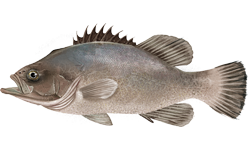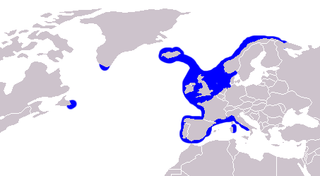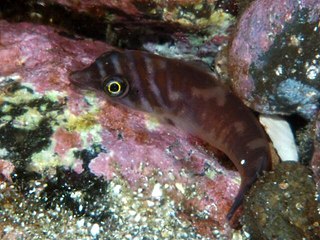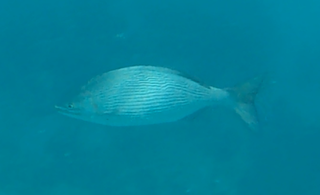
The black sea bass is a species of marine ray-finned fish, a sea bass from the subfamily Serraninae which is part of the family Serranidae, which also includes the groupers and anthias. It is found in the western Atlantic Ocean where it is an important species for commercial and recreational fisheries.

The Atlantic wreckfish,, also known as the stone bass or bass groper, is a marine, bathydemersal, and oceanodromous ray-finned fish in the family Polyprionidae. It has a worldwide, if disjunct, distribution in the Atlantic, Pacific and Indian Oceans.

The ballan wrasse is a species of marine ray finned fish from the family Labridae, the wrasses. It is found in the eastern Atlantic Ocean, where it inhabits rocky areas. Like many wrasse species, it is a protogynous hermaphrodite—all fish start life as females, and some dominant fish later become males. It is used as a food fish in some areas and it is also finding use as a cleaner fish in the aquaculture of Atlantic salmon in northwestern Europe.

The common ling, also known as the white ling or simply the ling, is a large member of the family Lotidae, a group of cod-like fishes. It resembles the related rocklings, but it is much larger and has a single barbel. This species is unrelated to the pink ling, Genypterus blacodes, from the Southern Hemisphere. The common ling is found in the northern Atlantic, mainly off Europe, and into the Mediterranean Basin. It is an important quarry species for fisheries, especially in the northeastern Atlantic, although some doubts exist as the sustainability of the fisheries. As an edible species, it is eaten fresh, frozen, or dried, but also preserved in lye, while the roe is a delicacy in Spain.

Clingfishes are fishes of the family Gobiesocidae, the only family in the order Gobiesociformes. These fairly small to very small fishes are widespread in tropical and temperate regions, mostly near the coast, but a few species in deeper seas or fresh water. Most species shelter in shallow reefs or seagrass beds, clinging to rocks, algae and seagrass leaves with their sucking disc, a structure on their chest.

The grey triggerfish or gray triggerfish, is a ray-finned fish in the triggerfish family. The species is native to shallow parts of the western Atlantic from Nova Scotia to Argentina and also the eastern Atlantic, the Mediterranean Sea and off Angola on the west coast of Africa.

The comber is a species of marine ray-finned fish from the family Serranidae, the sea basses. It is widely distributed in the eastern North and South Atlantic Oceans and into the southwestern Indian Ocean. It is caught for food and fishmeal in some parts of its range.

The greater amberjack, also known as the allied kingfish, great amberfish, greater yellowtail, jenny lind, purplish amberjack, reef donkey, rock salmon, sailors choice, yellowtail, and yellow trevally, is a species of predatory ray-finned fish in the family Carangidae, the jacks and pompanos. It is found in temperate, subtropical, and tropical seas around the world. It is a popular quarry species for recreational fisheries and is important in commercial fisheries. It is the largest species in the family Carangidae.

Cephalopholis taeniops, the African hind, bluespotted sea bass or spotted grouper, is a species of marine ray-finned fish, a grouper from the subfamily Epinephelinae which is in the family Serranidae which also includes the anthias and sea basses. This species occasionally makes its way into the aquarium trade and is a target for local fisheries. It is found in the eastern Atlantic Ocean.

Kyphosus sectatrix, the Bermuda chub, Pacific drummer, beaked chub, grey drummer, Pacific chub or white chub, is a species of marine ray-finned fish, a sea chub from the family Kyphosidae. This species is found in tropical and subtropical coastal waters worldwide. It has had a confused taxonomic history dating back to Linnaeus's naming of the species in 1758.

The ornate wrasse, Thalassoma pavo, is a species of wrasse native to the rocky coasts of the eastern Atlantic Ocean and the Mediterranean Sea. This species is of minor importance to local commercial fisheries, is also popular as a game fish, and can be found in the aquarium trade.

Montagu's blenny, also known as the capuchin blenny, is a species of combtooth blenny found in the intertidal zones of the eastern Atlantic ocean from England to Madeira and the Canary Islands as well the Mediterranean Sea, the Black Sea and the Sea of Marmara. This species prefers rocky shores with much wave action. This species grows to a length of 7.6 centimetres (3.0 in) SL. It is the only species in the genus Coryphoblennius.

The grey gurnard is a species of sea robin from the family Triglidae native to the eastern Atlantic Ocean, the Mediterranean Sea, and the Black Sea. It is caught as a food fish and is known for producing sounds. It is the only member of the monotypic genus Eutrigla.

The Portuguese blenny, also known as the red blenny, is a species of combtooth blenny found in the eastern Atlantic ocean off western Europe and Macaronesia.

Scorpaena scrofa, the red scorpionfish, bigscale scorpionfish, large-scaled scorpion fish, or rascasse is a venomous marine species of ray-finned fish in the family Scorpaenidae, the scorpionfishes. It is found in the eastern Atlantic Ocean and the western Indian Ocean.

The black scorpionfish, also known as the European scorpionfish or small-scaled scorpionfish, is a venomous scorpionfish, common in marine subtropical waters. It is widespread in the Eastern Atlantic Ocean from the British Isles to the Azores and Canary Islands, near the coasts of Morocco, in the Mediterranean Sea and the Black Sea.

Diplecogaster bimaculata, the two-spotted clingfish, is a species of fish in the family Gobiesocidae found in Black Sea, Mediterranean Sea and Atlantic Ocean where it is found on rocks and among seagrass or shell beds.

Kyphosus bigibbus, the brown chub, grey drummer, darkfin drummer, insular rudderfish, grey chub, grey sea chub, southern drummer or topsail drummer is a species of marine ray-finned fish, a sea chub from the family Kyphosidae. It is a herbivorous species which is found in subtropical and tropical seas worldwide.
Opeatogenys gracilis is a species of clingfish from the family Gobiesocidae which is found in the Mediterranean Sea and in the eastern Atlantic Ocean. Suggested common names for this species are the pygmy clingfish and the seagrass clingfish.

Apsilus dentatus, the black snapper, is a species of marine ray-finned fish, a snapper belonging to the family Lutjanidae. It is found in the western Atlantic Ocean.




















